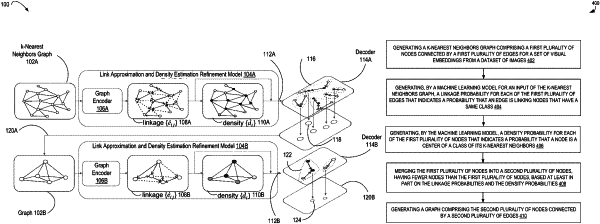| CPC G06F 18/2323 (2023.01) [G06F 18/23213 (2023.01); G06F 18/2415 (2023.01); G06F 18/24147 (2023.01); G06N 20/00 (2019.01)] | 20 Claims |

|
1. A computer-implemented method comprising:
generating a k-nearest neighbors graph comprising a first plurality of nodes connected by a first plurality of edges for a set of visual embeddings from a dataset of images where k is a positive integer;
generating, by a machine learning model for an input of the k-nearest neighbors graph, a linkage probability for each of the first plurality of edges that indicates a probability that an edge is linking nodes that have a same class;
generating, by the machine learning model, a density probability for each of the first plurality of nodes that indicates a probability that a node is a center of a class of its k-nearest neighbors;
merging the first plurality of nodes into a second plurality of nodes, having fewer nodes than the first plurality of nodes, based at least in part on the linkage probabilities and the density probabilities; and
generating a graph comprising the second plurality of nodes connected by a second plurality of edges.
|